
Cassinia is a genus of about fifty-two species of flowering plants in the family Asteraceae that are native to Australia and New Zealand. Plants in the genus Cassinia are shrubs, sometimes small trees with leaves arranged alternately, and heads of white, cream-coloured, yellow or pinkish flowers surrounded by several rows of bracts.

Ozothamnus diosmifolius is an erect, woody shrub in the daisy family, Asteraceae and is endemic to eastern Australia. Common names for this species include rice flower, white dogwood, pill flower and sago bush. It has dense heads of small white "flowers" and is often used in floral arrangements.

Dillwynia cinerascens, commonly known as grey parrot-pea, is a species of flowering plant in the family Fabaceae and is endemic to south-eastern Australia. It is an erect to low-lying shrub with linear or thread-like leaves and orange or yellow flowers.

Cassinia aculeata, commonly known as common cassinia, dolly bush or dogwood , is a species of flowering plant in the family Asteraceae and is endemic to south-eastern Australia. It is an erect shrub with sessile, linear, variably-sized leaves, and heads of creamy-white to white flowers arranged in rounded cymes.

Cassinia denticulata, commonly known as stiff cassinia, is a species of flowering plant in the family Asteraceae and is endemic to eastern New South Wales. It is a shrub with yellowish stems, finely-toothed, egg-shaped to elliptic leaves, and heads of pale yellow flowers arranged in a dense corymb.

Cassinia arcuata, commonly known as drooping cassinia, biddy bush, Chinese scrub, sifton bush and Chinese shrub is a species of flowering plant in the family Asteraceae and is endemic to Australia. It is a shrub, sometimes a small tree with sessile, linear leaves, and heads of up to two hundred brownish flowers arranged in pyramid-shaped panicles. In New South Wales, the species is known as Cassinia sifton. In disturbed areas, C. sifton can become weedy.

Olearia elliptica, commonly known as the sticky daisy bush, is a shrub in the daisy family, Asteraceae and is native to New South Wales and Queensland in eastern Australia. It has scattered, sticky leaves and white flowers in summer and autumn.

Cassinia aureonitens, commonly known as the yellow cassinia is a species of flowering plant in the family Asteraceae and is endemic to eastern New South Wales. It is a shrub with elliptic leaves and heads of yellow flowers arranged in dense corymbs.

Cassinia laevis, commonly known as cough bush, dead finish, curry bush or rosemary bush, is a species of flowering plant in the family Asteraceae and is endemic to south-eastern continental Australia. It is a shrub with a curry-like odour, crowded linear leaves, and heads of creamy-white flowers arranged in panicles.

Cassinia cunninghamii, commonly known as Cunninghams everlasting, is a plant native to central New South Wales in eastern Australia.
Cassinia compacta is a species of flowering plant in the family Asteraceae and is endemic to eastern Australia. It is a shrub with densely hairy stems, linear leaves and heads of yellow flowers arranged in dense corymbs.
Cassinia copensis is a species of flowering plant in the family Asteraceae and is endemic to eastern Australia. It is an erect, multi-stemmed shrub with aromatic, cylindrical leaves, and heads of creamy-white flowers arranged in a flattened corymb.
Cassinia decipiens is a species of flowering plant in the family Asteraceae and is endemic central New South Wales. It is a shrub with woolly-hairy young twigs, spreading, cylindrical leaves, and heads of creamy-brown to yellowish flowers arranged in a rounded cyme.
Cassinia furtiva is a species of flowering plant in the family Asteraceae and is endemic to a restricted area of New South Wales. It is a shrub with hairy, sticky stems, narrow linear leaves and 100 to 150 flower heads arranged in a rounded dichasium.

Asterolasia elegans is a species of slender, erect shrub that is endemic to a restricted area of New South Wales. It has dense, woolly, rusty star-shaped hairs on its stems, lance-shaped leaves densely covered with white and rust-coloured hairs on the lower surface, and white flowers arranged singly or in groups of up to nine in leaf axils or on the ends of branchlets, the back of the petals densely covered with woolly, white hairs.

Asterolasia correifolia is a species of erect shrub that is endemic to eastern Australia. It has white to brown star-shaped hairs on its stems, lance-shaped to elliptical leaves densely covered with white star-shaped hairs on the lower surface, and white to cream-coloured or yellow flowers arranged in umbels of four to ten or more in leaf axils, the back of the petals densely covered with white hairs.
Cassinia accipitrum is a species of flowering plant in the family Asteraceae and is endemic to eastern New South Wales. It is an erect shrub with spreading, dark green leaves that are covered with cottony hair on the underside, and heads of yellowish brown flowers arranged in rounded cymes.
Cassinia diminuta, commonly known as dwarf cassinia, is a species of flowering plant in the family Asteraceae and is endemic to Victoria in Australia. It is a small, erect, aromatic shrub with spreading, needle-shaped leaves that are covered with cottony hair on the underside, and corymbs of up to two hundred heads of flowers arranged in corymbs.
Cassinia complanata, commonly known as smooth cassinia, is a species of flowering plant in the family Asteraceae and is endemic to south-eastern Australia. It is a shrub with sticky, densely hairy stems, narrow linear to cylindrical leaves and heads of small flowers arranged in corymbs.
Cassinia heleniae is a species of flowering plant in the family Asteraceae and is endemic to a small area in northern New South Wales. It is a shrub with a few sticky stems, sticky needle-shaped leaves and flower heads arranged in a rounded to flat-topped cyme.











